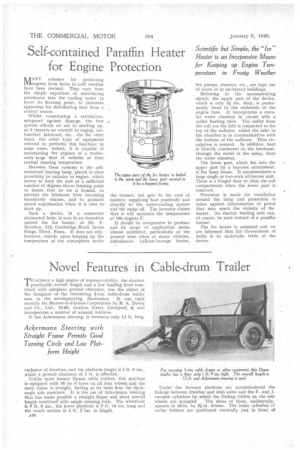Self-contained Paraffin Heater for Engine Protection
Page 26

If you've noticed an error in this article please click here to report it so we can fix it.
ANY schemes for protecting IVIengines from harm in cold weather have been devised. They vary from the simple expedient of introducing substances into the cooling water to lower its freezing point, to elaborate apparatus for distributing heat from a central source.
Whilst constituting a satisfactory safeguard against damage, the first .■ system affords no aid to starting up, as it imparts no warmth to engin,e, carburetter lubricant, etc. On the other hand, the other type of equipment referred to performs this function: in some cases, indeed, it is capable of maintaining the engines of a moderately large fleet of vehicles at their normal running temperature.
Between these systems is the selfcontained heating lamp, placed in close proximity to radiator or engine, which serves to keep the unit at a sufficient number of degrees above freezing point to insure that no ice is formed, to prevent the lubricant from becoming excessively viscous, and to promote petrol vaporization when it is time to Start U.
Such a device, in a somewhat elaborated form, is seen in an invention named the Ice heater, of Mr. F. Scrutton, 212, Cambridge Road, Seven Kings, Ilford, Essex. It does not rely, however, merely upon keeping up the temperature of the atmosphere under the bonnet, but gets to the root of matters, supplying heat positively and directly to the water-cooling system and the sump oil. The inventor claims that it will maintain the temperature at 100 degrees F.
It should be inexpensive to produce and its scope of application seems almost unlimited, particularly at the present time when so many vehicles, ambulances, balloon-barrage lorries, fire pumps, tractors, etc., are kept out of doors or in un-heated buildings.
Referring to the accompanying sketch, the upper part of the device, which is only 3i ins, deep, is permanently fixed to the underside of the engine base. It incorporates a circular water chamber in circuit with a coiled heating tube. The outlet from the coil (on the left) is connected to the top of the radiator, whilst the inlet to the chamber is in communication with the bottom of the radiator. Thus circuJation is assured. In addition, heat is directly conducted to the lubricant, through the metal of the sump, from the water chamber.
The lower part, which fits into the upper part by a bayonet attachment, is the lamp house. It accommodates a large single or two-wick oil-burner unit. There is a hinged door to close the coil compartment when the lower part is removed.
Provision is made for ventilation around the lamp and protection is taken against inflammation of petrol that may reach the vicinity of the heater. An electric heating unit can, of course, be used instead of a paraffin burner.
The Ice heater is patented and we are informed that the Government of India is to undertake trials of the device




























































